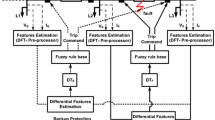Abstract
The aim is to study the characteristics of dual-net and dual-protection configuration of 750 kV substation and take into consideration the uncertainty of the substation, such as maloperation and rejection miss trip of protection and breaker. This paper proposed a diagnosis fault method with redundancy based on fuzzy Petri net in a framework of multi-agent system. The reasoning model is divided into global agent layer, local agent layer, and connected agent layer according to multi-agent hierarchical method, and the fault region and suspicious fault component are determined by the former two layer based on case information. The restriction and rule are formed by topological structure and protection configuration of grid. This algorithm adopts the information entropy to determine the credibility of initial information, the model of fuzzy Petri is established in the third layer and divided into main network and redundant network to carry out the sub-network, and then the diagnosis result with minimum uncertainty is obtained by fuzzy reasoning. The simulation results show this model has higher accuracy and better fault tolerance ability.














Similar content being viewed by others
References
Stigka EK, Paravantis JA, Mihalakakou GK (2014) Social acceptance of renewable energy sources: a review of contingent valuation applications. Renew Sustain Energy Rev 32:100–106
Sridhar S, Hahn A, Govindarasu M (2012) Cyber-physical system security for the electric power grid. Proc IEEE 100(1):210–224
Liu HC, Liu L, Lin QL et al (2013) Knowledge acquisition and representation using fuzzy evidential reasoning and dynamic adaptive fuzzy Petri nets. IEEE Trans Cybern 43(3):1059–1072
Wang T, Zhang G, Zhao J et al (2015) Fault diagnosis of electric power systems based on fuzzy reasoning spiking neural P systems. IEEE Trans Power Syst 30(3):1182–1194
Zhou KQ, Zain AM (2016) Fuzzy Petri nets and industrial applications: a review. Artif Intell Rev 45(4):405–446
Kyriakarakos G, Dounis AI, Arvanitis KG et al (2012) A fuzzy cognitive maps-Petri nets energy management system for autonomous polygeneration microgrids. Appl Soft Comput 12(12):3785–3797
Al-Muhaini M, Heydt GT (2013) A novel method for evaluating future power distribution system reliability. IEEE Trans Power Syst 28(3):3018–3027
Zeng R, Jiang Y, Lin C et al (2012) Dependability analysis of control center networks in smart grid using Stochastic Petri nets. IEEE Trans Parallel Distrib Syst 23(9):1721–1730
Liu HC, Lin QL, Mao LX et al (2013) Dynamic adaptive fuzzy Petri nets for knowledge representation and reasoning. IEEE Trans Syst Man Cybern Syst 43(6):1399–1410
Tan KH (2016) Squirrel-cage induction generator system using wavelet Petri fuzzy neural network control for wind power applications. IEEE Trans Power Electron 31(7):5242–5254
Marzougui B, Barkaoui K (2013) Interaction protocols in multi-agent systems based on agent Petri nets model. Int J Adv Comput Sci Appl 4(7):166–173
Dou CX, Liu B (2013) Multi-agent based hierarchical hybrid control for smart microgrid. IEEE Trans Smart Grid 4(2):771–778
Li Y, Chen J, Feng L (2013) Dealing with uncertainty: a survey of theories and practices. IEEE Trans Knowl Data Eng 25(11):2463–2482
Zhou KQ, Zain AM, Mo LP (2015) A decomposition algorithm of fuzzy Petri net using an index function and incidence matrix. Expert Syst Appl 42(8):3980–3990
Wang WM, Peng X, Zhu G et al (2014) Dynamic representation of fuzzy knowledge based on fuzzy Petri net and genetic-particle swarm optimization. Expert Syst Appl 41(4):1369–1376
Shen VRL (2006) Knowledge representation using high-level fuzzy Petri nets. IEEE Trans Syst Man Cybern Part A Syst Hum 36(6):1220–1227
Liang J, Zhao X, Li D et al (2012) Determining the number of clusters using information entropy for mixed data. Pattern Recognit 45(6):2251–2265
Kang HG, Seong PH (1999) A methodology for evaluating alarm-processing systems using informational entropy-based measure and the analytic hierarchy process. IEEE Trans Nucl Sci 46(6):2269–2280
Hu H, Li Z, Al-Ahmari A (2011) Reversed fuzzy Petri nets and their application for fault diagnosis. Comput Ind Eng 60(4):505–510
Acknowledgements
This work has been supported by the National Natural Science Foundation of P.R.China under Grant 51541710.
Author information
Authors and Affiliations
Corresponding author
Rights and permissions
About this article
Cite this article
Zhang, W., Ma, L., Li, X. et al. Research and application of fuzzy decision based on multi-agent system. J Supercomput 76, 4149–4168 (2020). https://doi.org/10.1007/s11227-018-2249-1
Published:
Issue Date:
DOI: https://doi.org/10.1007/s11227-018-2249-1




